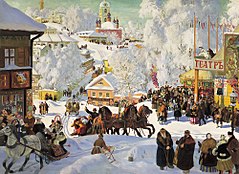Maslenitsa
| Maslenitsa | |
|---|---|

Maslenitsa, Boris Kustodiev, 1919 (Isaak Brodsky Museum, St. Petersburg)
|
|
| Also called | Масленица |
| Observed by | Russian and Ukrainian communities worldwide |
| Type | National |
| Significance | last week before Great Lent |
| Celebrations | Eating blini, snowball fights, sledding |
| 2016 date | 7 to 13 March |
| Frequency | annual |
| Related to | Mardi Gras |
Maslenitsa (Russian: Мaсленица, Ukrainian: Масниця, Belarusian: Масьленіца, also known as Butter Week, Crepe week, or Cheesefare Week), is an Eastern Slavic religious and folk holiday, celebrated during the last week before Great Lent, that is, the eighth week before Eastern Orthodox Pascha (Easter). Maslenitsa corresponds to the Western Christian Carnival, except that Orthodox Lent begins on a Monday instead of a Wednesday, and the Orthodox date of Easter can differ greatly from the Western Christian date.
According to archeological evidence from 2nd century A.D. Maslenitsa may be the oldest surviving Slavic holiday. Maslenitsa has its origins in the pagan tradition. In Slavic mythology, Maslenitsa is a sun-festival, personified by the ancient god Volos, and a celebration of the imminent end of the winter. In the Christian tradition, Maslenitsa is the last week before the onset of Great Lent.
During the week of Maslenitsa, meat is already forbidden to Orthodox Christians, and it is the last week during which eggs, milk, cheese and other dairy products are permitted, leading to its name of "Cheese-fare week" or "Crepe week". The most characteristic food of Maslenitsa is bliny thin pancakes or crepes, made from the rich foods still allowed by the Orthodox tradition that week: butter, eggs and milk.
Since Lent excludes parties, secular music, dancing and other distractions from spiritual life, Maslenitsa represents the last chance to take part in social activities that are not appropriate during the more prayerful, sober and introspective Lenten season.
...
Wikipedia
